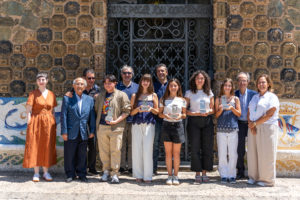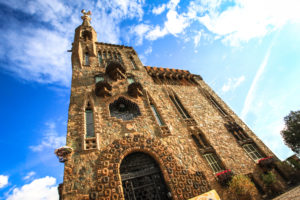By: Ferran Garcés
Header image: Nativity, Gueraru Gener, 1407-1411. Only the lower part, to focus on the nativity scene.

Gueraru Gener, Nativitat, 1407-1411
In the header image, we showcase the Nativity by the Gothic painter from Barcelona, Guerau Gener (1). This work is contemporaneous with the ancient Bellesguard Castle, as it was painted between 1407 and 1411. Did you know that in that era, in Catalonia, Christmas Day, and not January 1st, marked the beginning of a new year? We will discover this and other curiosities through a journey in time at Bellesguard. Will you join us?…
The ancient Bellesguard Castle
New Year before and after 313
The settlement of Bellesguard is very ancient. Archaeological remains trace it back, at least, to the Roman era. Therefore, the first celebrations in this place were pagan festivals like the Saturnalia and the festival of Sol Invictus. At that time, the first day of the year was January 1st, a result of the Julian calendar established by Julius Caesar in 47 B.C. A convention that wouldn’t last long…
In 313, Christianity became the official religion of the Roman Empire, and a few decades later, December 25th was officially decreed as the day Jesus was born. Those Roman cults were then replaced by the Christmas liturgy, and by the 6th and 8th centuries, the birth of Jesus, the essence of Christmas, marked the beginning of the Christian era. However, what remained unclear for a long time was which day should be the first day of the year.
During the early centuries of Christianity, the start of the year varied from one kingdom to another. For some, it should be March 25th, the day of the Annunciation when Jesus was conceived by the Holy Spirit; for others, December 25th, the day Jesus was born, or Resurrection Sunday. The tradition of celebrating New Year’s Day on January 1st in all Catholic kingdoms was not established until 1582, with the start of the Gregorian calendar, which is the current calendar in the West. However, not everyone adopted it immediately. In 18th-century Catalonia, it was still used, albeit only as a traditional convention parallel to the official computation based on the Gregorian calendar (3).
New Year of 1409
In 1409, the year when Martí I the Humane began to reside in Bellesguard Castle, the trend in Catalonia, as in the rest of the Crown of Aragon, was to celebrate the start of the year on the “Holy day of Christmas,” namely, December 25th. The decision was adopted by Pere IV, the Ceremonious, father of Martí I. Specifically, at the Cortes of 1350, held in the city of Perpignan (3).
1409 will be the last Christmas and the beginning of the year for the monarch of Bellesguard, as he will die in the middle of the following year. We don’t know how he celebrated it. Perhaps he ate neules, but not turrones, as these will come to the table in the 16th century. However, neules are older (4). We know they were served at the Christmas banquet of Jaume I in 1267, and in one of his sermons, Vincent Ferrer, one of the great saints of the Middle Ages and a great friend of the monarch, who also resided in Bellesguard Castle in that 1409 when the year began on the “Holy day of Christmas.”
In any case, in the time of King Martí, the main liturgical events of Christmas had already been established, such as Advent (much more important then than now), the midnight mass, Saint Stephen’s Day, and the Epiphany of the Three Wise Men. The names and number of the kings had also been established. Regarding the tradition of the Nativity scene, it is attributed to Saint Francis of Assisi, who invented it in 1223. However, Nativity scenes would not reach our homes until the change of the 18th century. Before that, they were limited to Italy and the church setting (5).
In these early years, the star of the Wise Men was usually represented with eight points and, by chance or coincidence, five centuries later, Gaudí would reproduce another octagram in the spectacular stained glass of Torre Bellesguard. A stained glass, by the way, that projects the reflection of that star onto the opposite wall on Christmas day (5).
How did you find the journey through time? Next Friday, we will resume by visiting more recent chapters of history, chapters where the new year already begins on January 1st. In this new installment, we will witness, among other traditions, the first Christmas trees in Catalonia, as well as the processions of the Three Kings, the arrival of Santa Claus, the first toasts with cava, and 12 grapes. We hope to see you then. Until then, and Happy New Year, whenever it may be.
Notes
Casas, Martí (4/01/2018), “Christmas Scenes at the National Museum,” blog of the National Art Museum of Catalonia. Link
For this and the following references, the main source is: Pepe Rodríguez (2010), Myths and Traditions of Christmas, Ediciones B, Barcelona.
Regarding the origins of Christmas, you can also check on our blog the following entry: “Did You Know? The Origin of Christmas.” Link
Vilatella Ortiz, Xavier (30/12/2020), “New Year’s Eve in March: Since When Do We Celebrate New Year on January 1st?” La Vanguardia. Link
Paola, Martí (27/12/2021), “In Catalonia, New Year’s Eve hasn’t always been on December 31st,” RAC1 website. Link
Estela, Ester (24/12/2018), “Neules, the Oldest Christmas Desserts?” Vilaweb.cat. Link
For the reference to Vicent Ferrer, see also: Redacción, “neula,” Catalan-Valencian-Balearic Dictionary, Institute of Catalan Studies website: link
Prats, Mireia (17/12/2022), “The Secrets of the Nativity Scene, a Tradition that Arrived from Italy in the 18th Century,” 3cat.cat website. Link
See on our blog: “10th Anniversary: The Bellesguard Research Group.” Link




